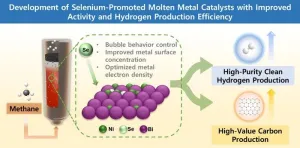(Press-News.org) Researchers in South Korea have developed an advanced liquid metal catalyst incorporating selenium (Se) to enhance the efficiency of turquoise hydrogen production.
Turquoise hydrogen is generated via methane (CH₄) pyrolysis, producing hydrogen while yielding solid carbon as a byproduct, without emitting carbon dioxide (CO₂).
A research team led by Dr. Seung Ju Han at the Korea Research Institute of Chemical Technology (KRICT) has introduced selenium-doped molten metal catalysts (NiBi, CuBi) to significantly enhance methane pyrolysis efficiency. The technology demonstrates high methane conversion rates and stable catalyst performance, paving the way for sustainable clean hydrogen production.
Methane pyrolysis is a promising eco-friendly hydrogen production method, as it generates solid carbon instead of CO₂ emissions. However, existing approaches face challenges, such as requiring extremely high temperatures or experiencing catalyst deactivation due to carbon deposition on solid catalysts.
To address these challenges, the research team developed a ternary molten metal catalyst incorporating selenium, which enhances catalyst activity and controls bubble formation during the reaction.
Unlike conventional solid catalysts, molten metal catalysts remain in a liquid state, allowing for efficient separation of carbon byproducts and ensuring long-term stable reactions.
Selenium incorporation reduces surface tension, maximizing the contact area between reactant gases and the catalyst, leading to increased hydrogen production efficiency.
Selenium also lowers the activation energy required for methane conversion, thereby improving catalytic performance. Notably, selenium promotes the surface exposure of nickel active sites, further enhancing methane decomposition efficiency.
Selenium addition reduces the surface tension of NiBi-based catalysts by approximately 19%, leading to smaller bubbles and an increased catalyst contact area, significantly improving reaction efficiency. The newly developed selenium-promoted ternary catalysts (NiBiSe, CuBiSe) achieved methane-to-hydrogen conversion efficiencies that improved by 36.3% and 20.5%, respectively, compared to conventional catalysts.
Notably, the NiBiSe catalyst maintained stable performance for over 100 hours, demonstrating exceptional long-term stability.
The research team believes that this breakthrough technology has the potential to accelerate the commercialization of clean hydrogen production. Future research will focus on further improving process efficiency and targeting commercial deployment by 2030.
"This research overcomes key limitations of existing turquoise hydrogen production technologies and is expected to make a significant contribution to achieving carbon neutrality," the researchers stated.
Dr. Yeong-Kuk Lee, President of KRICT, added, "This technology is a core innovation for carbon-free turquoise hydrogen production and will play a crucial role in its commercialization."
###
KRICT is a non-profit research institute funded by the Korean government. Since its foundation in 1976, KRICT has played a leading role in advancing national chemical technologies in the fields of chemistry, material science, environmental science, and chemical engineering. Now, KRICT is moving forward to become a globally leading research institute tackling the most challenging issues in the field of Chemistry and Engineering and will continue to fulfill its role in developing chemical technologies that benefit the entire world and contribute to maintaining a healthy planet. More detailed information on KRICT can be found at https://www.krict.re.kr/eng/
This study was published in Applied Catalysis B: Environmental and Energy in December 2024. The research was led by Dr. Seung Ju Han at KRICT and Dr. Jeong-Cheol Seo at the Korea Institute of Industrial Technology, with Ju Ho Son, a researcher at KRICT and Yonsei University, as the first author.
This research was supported by KRICT's core research program and the National Research Foundation of Korea’s Carbon Upcycling Platform Compounds Research Project, funded by the Ministry of Science and ICT.
END
Novel molten metal catalysts for CO2-free hydrogen production
Methane-to-hydrogen conversion efficiency improved by up to 36.3% using selenium-enhanced molten metal catalysts
2025-02-26
ELSE PRESS RELEASES FROM THIS DATE:
Beyond the burn: Harvesting dead wood to reduce wildfires and store carbon
2025-02-26
A century of fire suppression, combined with global warming and drought, has led to increasingly destructive wildfires in the Western United States. Forest managers use tools like prescribed burns, thinning, mastication, and piling and burning to reduce fuel – live and dead trees, needles and leaves, and downed branches – that can feed intense wildfires. These methods aim to lower fuel levels, reduce crown density, and protect fire-resistant trees, fostering healthier, more resilient forests.
However, prescribed burning efforts haven’t kept up with the rapid buildup of surface fuel, creating a “fire deficit” – the gap between the amount of fuel that has ...
Researchers at Case Western Reserve, University Hospitals to begin clinical testing with new, less-invasive technology to screen for esophageal precancer
2025-02-26
CLEVELAND—Researchers at Case Western Reserve University (CWRU) and University Hospitals (UH) will use state-of-the-art medical technologies they invented—and licensed to Lucid Diagnostics Inc.—to detect esophageal precancer, specifically Barrett’s Esophagus (BE).
BE is a change in the cellular structure of the esophageal lining typically caused by gastroesophageal reflux disease (GERD), also known as heartburn. The goal is to reduce the incidence of esophageal cancer (EAC).
EAC is a rare type of cancer with a high-morality rate—the cause of 2.6% of all cancer ...
JMC|With generative AI assistance, Insilico Medicine announces novel CDK12/13 dual inhibitors for tumor treatment
2025-02-26
Insilico Medicine ("Insilico"), a clinical stage generative artificial intelligence (AI)-driven biotechnology company, today announced the publication of a novel series of orally available covalent CDK12/13 dual inhibitors, as a potential option against refractory and treatment-resistant cancers. Published in the Journal of Medicinal Chemistry (IF=7.2), the study showcases the discovery of compound 12b, a potent, selective, and safe therapy targeting CDK12/13, empowered by Insilico’s proprietary generative AI platforms including PandaOmics and ...
Novel photochromic glass can store rewritable 3D patterns
2025-02-26
For decades researchers have been exploring how to store data in glass because of its potential to hold information for a long time — eons — without applying power. A special type of glass that changes color in different wavelengths of light, called photochromic glass, holds promise for stable, reusable data storage. Now, researchers have developed a doped photochromic glass that has the potential to store rewritable data indefinitely, according to research published in ACS Energy Letters.
Certain types of ...
Sea sponge inspires super strong compressible material
2025-02-26
Inspired by the humble deep-sea sponge, RMIT University engineers have developed a new material with remarkable compressive strength and stiffness that could improve architectural and product designs.
The double lattice design was inspired by the intricate skeleton of a deep-sea sponge known as Venus' flower basket, which lives in the Pacific Ocean.
Lead author of the latest RMIT study into the structure, Dr Jiaming Ma, said extensive testing and optimisation revealed the pattern's impressive combination of stiffness and strength, mixed with an ability to contract when compressed.
It’s this last aspect – known as auxetic behaviour – ...
AI generates playful, human-like games
2025-02-26
While we are remarkably capable of generating our own goals, beginning with child’s play and continuing into adulthood, we don’t yet have computer models for understanding this human ability.
However, a team of New York University scientists has now created a computer model that can represent and generate human-like goals by learning from how people create games. The work, reported in the journal Nature Machine Intelligence, could lead to AI systems that better understand human intentions and more faithfully model ...
Bacteria ‘leaking across stomach lining’ could indicate risk of gastric cancer, new study has found
2025-02-26
A pioneering study has revealed new insights into the role of gastric bacteria in stomach cancer development that could pave the way for a more effective treatment of pre-cancer according to a study published today in Helicobacter.
The Royal Society and Cancer Research UK-funded research led by Dr Amanda Rossiter-Pearson at the University of Birmingham identified a crucial interaction between Helicobacter pylori and non-H. pylori bacteria in the pre-cancerous stage of gastric cancer.
Gastric cancer is the fourth ...
Feeding anemone: Symbiote fish actively feed hosts in wild
2025-02-26
Anemonefish, sometimes called clownfish, have been popular attractions in aquariums ever since Disney’s animated film Finding Nemo arrived in cinemas in 2003. Living symbiotically with sea anemones that shelter them from predators, the fish drive away organisms that nibble at their hosts. Anemonefish have also shown they will provide their hosts with the food given to them by humans, but does this happen in the wild?
An Osaka Metropolitan University Graduate School of Science team led by PhD student Yuya Kobayashi and Professor Satoshi Awata found evidence of this feeding behavior during field experiments. ...
New AI-powered tool could enhance traumatic brain injury investigations in forensics and law enforcement
2025-02-26
A team of researchers from the University of Oxford, in collaboration with Thames Valley Police, the National Crime Agency, the John Radcliffe Hospital, Lurtis Ltd. and Cardiff University, has developed an advanced physics-based AI-driven tool to aid the forensic investigation of traumatic brain injuries (TBI).
The study, published today (26 Feb) in Communications Engineering, introduces a mechanics-informed machine learning framework to help police and forensic teams accurately predict TBI outcomes based on documented assault scenarios.
TBI is a critical public health issue, with severe and long-term neurological consequences. In forensic investigations, determining ...
A protein from tiny tardigrades may help cancer patients tolerate radiation therapy
2025-02-26
CAMBRIDGE, MA -- About 60 percent of all cancer patients in the United States receive radiation therapy as part of their treatment. However, this radiation can have severe side effects that often end up being too difficult for patients to tolerate.
Drawing inspiration from a tiny organism that can withstand huge amounts of radiation, researchers at MIT, Brigham and Women’s Hospital, and the University of Iowa have developed a new strategy that may protect patients from this kind of damage. Their approach makes use of a protein from tardigrades, often also called “water bears,” which are usually less than a millimeter in ...
LAST 30 PRESS RELEASES:
Kids’ behavioral health is a growing share of family health costs
Day & night: Cancer disrupts the brain’s natural rhythm
COVID-19 vaccination significantly reduces risk to pregnant women and baby
The role of vaccination in maternal and perinatal outcomes associated with COVID-19 in pregnancy
Mayo Clinic smartwatch system helps parents shorten and defuse children's severe tantrums early
Behavioral health spending spikes to 40% of all children’s health expenditures, nearly doubling in a decade
Digital cognitive behavioral treatment for generalized anxiety disorder
Expenditures for pediatric behavioral health care over time and estimated family financial burden
Air conditioning in nursing homes and mortality during extreme heat
The Alps to lose a record number of glaciers in the next decade
What makes a good proton conductor?
New science reporting guide published for journalists in Bulgaria
New international study reveals major survival gaps among children with cancer
New science reporting guide published for journalists in Turkey
Scientists develop a smarter mRNA therapy that knows which cells to target
Neuroanatomy-informed brain–machine hybrid intelligence for robust acoustic target detection
Eight SwRI hydrogen projects funded by ENERGYWERX
The Lundquist Institute and its start-up company Vitalex Biosciences Announces Strategic Advancement of Second-Generation fungal Vaccine VXV-01 through Phase 1 Trials under $40 Million Competitive Con
Fine particles in pollution are associated with early signs of autoimmune disease
Review article | Towards a Global Ground-Based Earth Observatory (GGBEO): Leveraging existing systems and networks
Penn and UMich create world’s smallest programmable, autonomous robots
Cleveland researchers launch first major study to address ‘hidden performance killer’ in athletes
To connect across politics, try saying what you oppose
Modulating key interaction prevents virus from entering cells
Project explores barriers to NHS career progression facing international medical graduates
Jeonbuk National University researchers explore the impact of different seasonings on the flavor perception of Doenjang soup
Two Keck Medicine of USC Hospitals named Leapfrog Top Teaching Hospitals
World-first discovery uncovers how glioblastoma tumours dodge chemotherapy, potentially opening the door to new treatments
A fatal mix-up: How certain gut bacteria drive multiple sclerosis
New AI tool identifies not just genetic mutations, but the diseases they may cause
[Press-News.org] Novel molten metal catalysts for CO2-free hydrogen productionMethane-to-hydrogen conversion efficiency improved by up to 36.3% using selenium-enhanced molten metal catalysts







